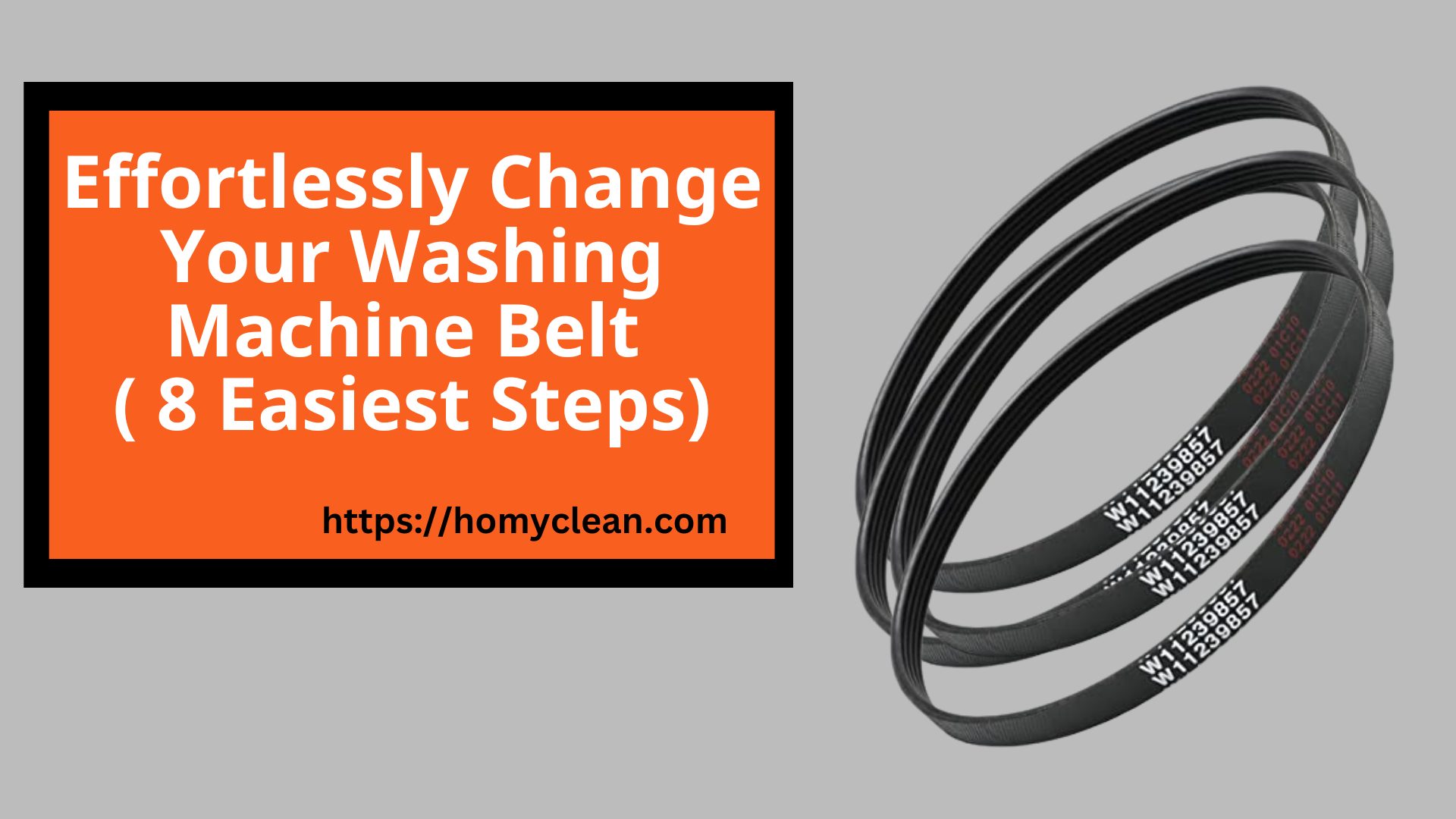Changing a washing machine belt is a straightforward DIY repair that most homeowners can complete with some basic skills and the right tools. Here’s a step-by-step guide on how to change washing machine belt:
1. Safety First
To protect yourself while working on the washing machine, start by unplugging it from the electrical outlet and shutting off the water supply.
2. Locate the Belt Routing Diagram
Check inside the washing machine’s cabinet or on the back for a diagram that shows how the belt is routed through the pulleys. This diagram will be your guide during the replacement process.
3. Remove the Front Panel
Typically, the washing machine’s front panel is held in place by a few screws. Use a screwdriver to remove these screws, then carefully lift and remove the front panel from the machine.
4. Note Belt Routing
Once the front panel is off, locate the motor, pulley, and belt. Take note of how the old belt is routed through the pulleys.
5. Remove the Old Belt
Carefully slide the old belt off the pulleys. If it’s stuck or challenging to remove, you may need to gently loosen it with a pry bar or pliers.
6. Check for Misalignment
If your washing machine belt frequently comes off, it might be due to misalignment or a loose tensioner pulley. Ensure that the pulley is correctly aligned and tightened. Also, verify that the belt is the correct size and not worn out.
7. Install the New Belt
Take the new belt and route it through the pulleys following the belt routing diagram. Ensure it’s properly aligned and tensioned.
8. Reassemble the Washing Machine
Carefully reattach the front panel and secure it with the screws you removed earlier.
9. Reconnect and Test
Plug the washer back into the electrical outlet and turn the water supply back on. Test the machine to make sure it’s working properly. If you encounter any issues, double-check the belt’s alignment and tension.
Changing the washing machine belt is a cost-effective DIY repair that can save you money on professional service fees. With some basic hand tools and a little patience, you can easily complete this task.
Similar Topic: How to Put Belt on Washing Machine
How Washing Machine Belts Work
During the wash cycle, the washing machine’s drive motor turns a pulley, which, in turn, rotates the drum. The belt’s role is to transfer the rotational motion from the pulley to the drum. As the drum rotates, it agitates the clothes, facilitating the cleaning process.
If the belt becomes damaged or wears out, it can lead to washing machine malfunctions. Therefore, replacing a worn-out or damaged belt can help restore proper functionality.
Signs Washing Machine Belt Needs Replacement
- Drum not spinning during the wash cycle.
- Unusual loud noises during operation.
- A burning smell when the machine is running.
- Incomplete wash cycles.
- Excessive vibrations during operation.
- Visible damage or wear on the belt.
If you notice any of these signs, it’s a good idea to inspect and replace the washing machine belt if necessary, or seek professional assistance for a proper diagnosis and repair.
How to Tighten or Stretch a Washing Machine Belt
- Tighten: To tighten a loose washing machine belt, locate the belt and drive motor pulley. Use a wrench to turn the tensioner pulley clockwise to increase tension. If it remains loose, loosen the mounting screws on the back of the washing machine and shift the drum to create more tension. Then, re-tighten the mounting screws.
- Stretch: If the belt is too tight, adjust the tension by turning the tensioner pulley counterclockwise with a wrench. If it’s still too tight, loosen the mounting screws on the back and shift the drum to provide more slack. Re-tighten the mounting screws.
Common Causes of Washing Machine Belt Breakage
- Age and wear.
- Getting caught or tangled on objects.
- Unbalanced load in the machine.
- Overloading the machine.
- Incorrect belt installation.
- Using the wrong type or size of belt.
- Incorrect tension.
- Damage to the belt.
- Operating the machine with a damaged drum or other mechanical issues.
Lifespan of Washing Machine Belt
The lifespan of a washing machine belt can vary depending on factors such as belt quality, frequency of use, and maintenance. Typically, a washing machine belt can last between five and ten years. However, if it experiences damage or excessive wear, it may need replacement sooner.
Direct Drive vs. Belt Drive Washing Machines
Both direct drive and belt drive washing machines have their advantages:
- Direct Drive: These machines are often more efficient, quieter, and durable, as they have fewer mechanical parts that can break down.
- Belt Drive: Belt drive machines are more traditional in design and may be easier to repair if issues arise.
The choice between them depends on your specific preferences and needs.
Replacing a Belt on an Amana Washing Machine
To replace a belt on an Amana washing machine, follow these steps:
- Unplug the machine and shut off the water supply.
- Remove the access panel or back panel to access the belt.
- Loosen the belt’s tension by adjusting the tensioner or idler pulley.
- Slide the old belt off the motor pulley and drum.
- Install the new belt, ensuring proper alignment.
- Retighten the belt’s tension using the tensioner or idler pulley.
- Replace the access panel or back panel.
- Plug in the machine and restore the water supply.
Changing the Belt on Roper Washing Machine
To change the belt on a Roper washing machine, follow these steps:
- Unplug the machine and turn off the water supply.
- Remove the lint filter and unscrew the screws holding the top panel.
- Lift off the top panel and set it aside.
- Locate the belt and belt tensioner.
- Release belt tension by pressing down on the tensioner arm.
- Slide the old belt off the pulleys.
- Install the new belt, ensuring proper alignment.
- Re-tension the belt by releasing the tensioner arm.
- Replace the top panel, screws, and lint filter.
- Plug in the machine and restore the water supply.
FAQs About How to Change washing machine Belt
Where to Buy a Washing Machine Belt
You can purchase washing machine belts at appliance repair stores, home improvement stores, or online retailers. Be sure to have your washing machine’s make and model number for accurate belt selection.
Cost of Washing Machine Belt
The cost of a washing machine belt varies based on the machine’s make and model, as well as the type of belt required. Generally, expect to spend between $10 and $50 for a replacement belt. Compare prices from multiple sources to find the best deal.
Ease of Changing a Washing Machine Belt
Changing a washing machine belt can be a manageable DIY task for those comfortable with basic repairs and following instructions. However, the ease may vary depending on your machine’s model and design.
Determining When Your Washing Machine Belt Needs Replacement
If your washing machine makes loud noises, vibrates excessively, or experiences spinning or agitating issues during the wash cycle, these can be signs of a worn or damaged belt, indicating the need for replacement.
Can a Washing Machine Operate Without a Belt
No, a washing machine cannot function without a belt. The belt is essential for transferring power from the motor to the drum, enabling it to spin and agitate during the wash cycle. If the belt is missing or broken, the machine will not operate correctly.
Troubleshooting a Washing Machine Belt That Keeps Falling Off
If your washing machine belt keeps coming off, consider checking for misalignment of pulleys, tensioner pulley issues, belt size and condition, and proper installation. If problems persist, consult a professional technician for further diagnosis and repair.
Changing a washing machine belt is a manageable DIY repair that can help maintain your machine’s functionality. Safety precautions, careful alignment, and proper tension are crucial during the replacement process. If you encounter difficulties or uncertainties, it’s wise to consult your washing machine’s owner’s manual or seek professional assistance.
Recommended Topics:
If you want to read all the laundry related articles, visit here. Visit here for the 10 best washing machine cleaner, visit homyclean for Products Review.





